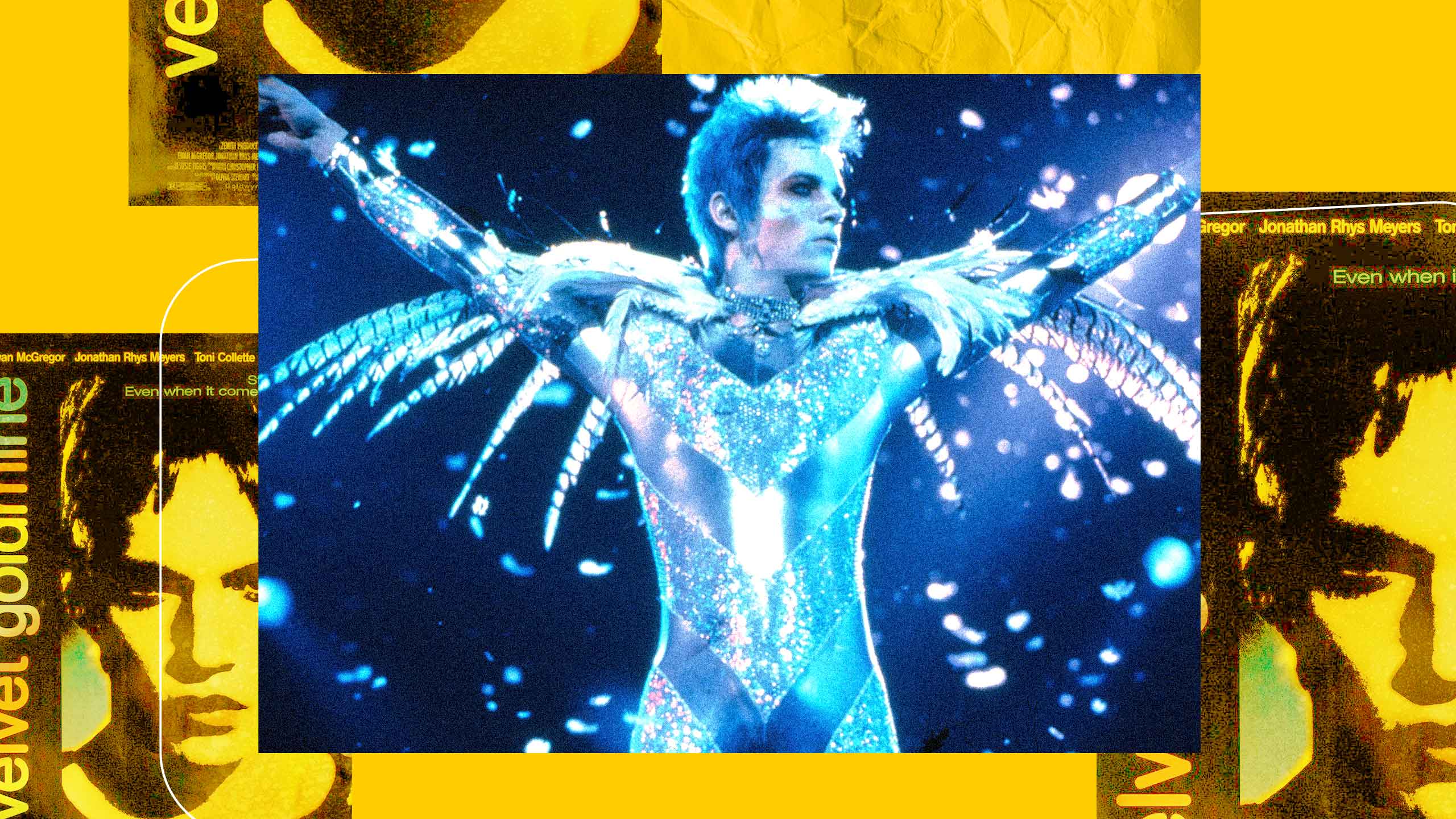In 1998, director Todd Haynes gave the world Velvet Goldmine, a wildly ambitious love letter to the British glam-rock scene of the 1970s. The film’s plot revolves mainly around the events leading up to glam superstar Brian Slade (Jonathan Rhys Myers) faking his own death in 1974, and journalist Arthur Stuart’s (Christian Bale) attempts to track him down 10 years later. As Stuart pieces together the story from interviews with those who knew Slade best, his own formative memories of the 1970s begin to bubble to the surface, and we see how Slade’s flamboyantly theatrical, gender-bending image and open bisexuality came to shape a young Stuart’s understanding of his own queerness.
However, describing the film solely in terms of its plot sells it short. Velvet Goldmine is just as devoted to its visually arresting musical numbers and set pieces, such as a hallucinatory sex scene set to a cover of Roxy Music’s “Ladytron,” or a bizarre press conference sequence, set in a circus arena, where Slade quotes Oscar Wilde. The film’s soundtrack proves to be its most vital element; even in Velvet Goldmine’s most plot-driven moments, there’s barely a story beat that doesn’t have a corresponding song heightening the emotion. Everything is turned up to the level of pure, dazzling spectacle.
But what’s the value of a spectacle if no one comes to see it? Initially, the film was a flop, making back a disappointing USD$4.3 million of its $9-million budget. Critical reception was mixed, too, with a common complaint being that the film’s narrative had too many conflicting elements to keep track of; it felt busy and disjointed. To be fair, those critiques aren’t entirely unwarranted: Velvet Goldmine flits feverishly, sometimes confusingly, between various characters’ memories of the glam-rock scene of the 1970s, Stuart’s attempts to piece it all together in 1984, several elaborate musical numbers, various references to Citizen Kane and a completely disconnected subplot that implies Oscar Wilde may or may not have been sent to Earth by aliens. However, in spite (or because) of its excesses, the film has steadily gained a cult following in subsequent years. “It’s the film [of mine] that seems to mean the most to a lot of teenagers and young people, who are just obsessed with that movie,” Haynes said in a 2007 interview. “They’re exactly who I was thinking about when I made Velvet Goldmine, but it just didn’t get to them the first time around.”
My friend Amber, a fellow Montreal musician, is just one of many whose life was changed by Velvet Goldmine. She watched it for the first time on cable TV with her twin sibling, Maranda.
“I would have been 14 or 15, and I was in my kinda-goth, kinda-nu-metal phase, and Velvet Goldmine kicked me out of it and showed me something much more interesting that I could actually relate to,” Amber says. “After I watched it I made myself a homemade Placebo shirt. It was a pink T-shirt and I spelled out ‘Placebo’ on it with glitter glue, and it was one of the first things I wore that wasn’t a black T-shirt.”
“The movie depicted homophobia and bullying, but it also depicted escape, magic, beauty, love, play.”
There were more viewings. “We could recite the entire film line-by-line,” Amber’s twin sibling, writer Maranda Elizabeth, says, “and there was even a time when we watched it every single day. I remember being isolated and dreaming of when I could grow up and move to the city. Without the vocabulary for it, I was experiencing what would later be labelled (accurately or not) as body dysmorphia and gender dysphoria. All I knew was that I hated having a body, hated wearing clothes but hated being naked, too, hated having skin, hated being looked at, hated leaving my bedroom for anywhere but the library or the thrift store.
“Velvet Goldmine was very colourful in contrast with the world I was living in,” Maranda says. “The movie depicted homophobia and bullying, but it also depicted escape, magic, beauty, love, play. When I was a teenager, the most I hoped for was to get to the city and become a squeegee kid and have my own apartment somewhere. I didn’t know I could want much else.”
In order to sell the idea that glam rock was a bastion of “escape, magic, beauty, love, play” in a colourless world (a contrast that the film itself plays with, depicting the mid-’80s as grey, lifeless and dystopian in comparison to Stuart’s memories of the ’70s), Velvet Goldmine needed to ensure that its soundtrack was every bit as alive and exciting as its visuals. Here, Haynes met a snag that could very well have derailed his project: David Bowie, the main inspiration for the Brian Slade character, refused to allow his songs in the film. One of the reasons he publicly gave was that he found the film’s depiction of Slade as a shameless opportunist to be too cynical: “It didn’t understand how innocent everyone was then about what they were getting into,” Bowie said in a 1999 interview. “Also, there was a lot more shopping—trawling round Liberty’s looking for fabric. It was hysterical.”
Bowie’s rejection of the film does make some sense. The plot can be seen as gay Bowie fanfiction: Slade and fellow rocker Kurt Wild (an amalgamation of Mick Ronson and Iggy Pop played by Ewan McGregor) are implied to be lovers. And Slade is portrayed as a self-absorbed jerk who throws everyone who ever supported him under the bus—up to and including the queer community that looked up to him. This, we must remember, is a perspective not uncommon to that of queer fans who saw Bowie’s 1983 denial of being gay or bisexual as an act of betrayal.
Necessity soon became the mother of invention. Haynes drafted in some of the hippest rock bands of the time to score the scenes originally scripted with Bowie’s songs in mind. It could be argued that this made the film stronger than it might otherwise have been—having new songs that uncannily mimic the ’70s glam-rock sound adds to the film’s feeling of a bygone era being reconstructed from fractured, imperfect memories.
The modern-retro approach also means that the accompanying soundtrack album functions as a work of art in its own right: setting new material alongside established glam-rock classics like “Satellite of Love” and “Virginia Plain” posits glam as not only something to be nostalgic for, but as a genre with continued relevance in the present day. Lest we forget, in 1998, rock still hadn’t found a clear way forward from the decline of grunge and Britpop; the defensive tough-guy masculinity of nu-metal bands like Staind and Limp Bizkit was still a couple of years away from dominating the airwaves.
The Velvet Goldmine soundtrack captures a transitional period in music, and shows a potential future unfulfilled. In the soundtrack’s imaginary world, Pulp have abandoned any trace of writerly pretension and refinement in favour of stomping stadium glam; Grant Lee Buffalo have traded in their earnest Americana-worship in favour of English music-hall camp; and the sensitive power-pop geeks in Teenage Fanclub (alongside raspy-voiced Elastica guitarist Donna Matthews) got to be The New York Dolls for a day. Perhaps the most dramatic transformation of all comes from a completely unrecognizable Thom Yorke, crooning Roxy Music covers with a full-throated, passionate sensuality that he’d never tapped into before (and, as of this writing, never has again). Such is the magic of glam: it turns out that everybody feels a little sexier in makeup and sequins—even the lead singer of Radiohead.
“As Stuart flashes back to his youth, we see how he discovered his homosexuality through glam.”
In a way, this articulates one of the film’s key themes, which is how ’70s rock’s defiance of cishet sexual and gender norms created a space where everyone was far freer to express themselves. As Stuart flashes back to his youth in the 1970s from the vantage point of 1984, we see how he discovered his homosexuality through glam, and later found in glam a community who would love and accept him for who he is. In a perfect twist, part of that community is played by the members of Placebo, one of the few bands on the soundtrack whose main singer, Brian Molko, is openly queer. Given that they were part of a tiny glam revival earlier in the 1990s, one that also included bands like Spacehog and Suede, their cover version of T. Rex’s “20th Century Boy”—which takes place in the film at a live show commemorating the “Death Of Glitter” at the tail end of the original glam-rock era—feels practically predestined.
And finally, somewhere in the space between Placebo being themselves and everyone else going wildly off script, there is Shudder to Think. Though the band has often been described as “theatrical” and has dabbled with homoerotic imagery in the videos promoting their 1994 major-label debut, Pony Express Record, the band’s glammier leanings were often obscured by how willfully abrasive and difficult their music could be. In Velvet Goldmine, however, they rein themselves in and deliver two dead-on David Bowie pastiches in the form of “Hot One” and “The Ballad of Maxwell Demon.” In the context of the film, these are Brian Slade’s biggest hits, and the latter winds up being one of the film’s most ornate musical set pieces, wherein a shimmering, blue-skinned creature plays guitar in a burning dollhouse. There’s a delicious irony at work here that adds to the soundtrack’s parallel-universe feel: on an album that includes some of the most acclaimed names in rock at the time, it’s the spiky, difficult weirdos in Shudder to Think who come out seeming like the biggest stars.
Critics weren’t kind to Velvet Goldmine. “It wants to be a movie in search of a truth, but it’s more like a movie in search of itself,” wrote Roger Ebert. Now, though, the film is just one of many celebrated films in Haynes’ growing filmography. His new documentary on the band The Velvet Underground premiered at Cannes to widespread acclaim, which feels as perfect and inevitable, in its own way, as Placebo’s T. Rex cover.
Sadly, Velvet Goldmine’s soundtrack has fallen out of print and is impossible to find on streaming services. Much like the film itself, it remains an open secret, just waiting for the right people to discover it. As for the film’s enduring appeal among fans, I’ll let Maranda have the last word:
“Today, when I meet new people, and especially when I’m dating somebody new, I always insist we watch Velvet Goldmine together so they can begin to have an idea about my own gender expression and sexuality, an idea of some of the early influences that have made me who I am today.”


 Why you can trust Xtra
Why you can trust Xtra


